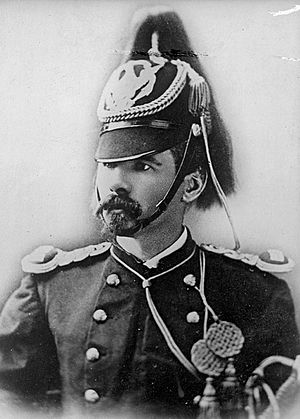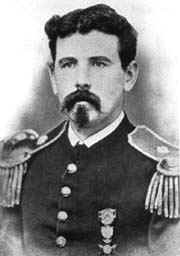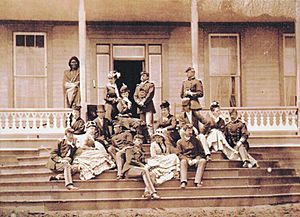Myles Keogh facts for kids
Myles Walter Keogh (born March 25, 1840 – died June 25, 1876) was a brave Irish soldier. He fought in the army of the Papal States during the war for Italian unification in 1860. Later, he joined the Union Army during the American Civil War.
Keogh was a cavalry officer, especially known for serving under General John Buford during the Gettysburg Campaign and the three-day Battle of Gettysburg. After the Civil War, Keogh stayed in the United States Army. He commanded Company I of the 7th Cavalry Regiment under George Armstrong Custer during the Indian Wars. He was killed along with Custer and his men at the Battle of the Little Bighorn in 1876.
Contents
Early Life and Military Start
Myles Keogh was born in Leighlinbridge, County Carlow, Ireland, on March 25, 1840. His family were farmers, growing barley. This meant they were not as affected by the Great Famine (1845-1850). However, Myles and some of his siblings did suffer from typhoid as children.
He went to the National School in Leighlinbridge. It is thought he also attended a college to study classics.
Joining the Papal Army
In 1860, when he was 20, Myles Keogh volunteered to defend Pope Pius IX. Over a thousand Irishmen joined the Papal Army. By August 1860, Keogh became a second lieutenant in the Battalion of St. Patrick. He was stationed in Ancona, a port city in Italy.
The Papal forces were defeated in September at the Battle of Castelfidardo. Ancona was surrounded, and Keogh's unit had to surrender. He was briefly imprisoned but quickly released. In Rome, he joined the Vatican Guard. For his bravery, he received the Pro Petri Sede Medal and the Cross of a Knight of the Order of St. Gregory the Great.
Moving to America
After the fighting ended, Keogh decided to leave Rome. The American Civil War was happening, and the U.S. Secretary of State, William H. Seward, was looking for experienced European officers. Archbishop John Hughes of New York helped recruit veterans from the Papal War.
In March 1862, Keogh resigned from the Vatican Guard. He traveled to New York with another officer, Daniel J. Keily. They arrived on April 2.
American Civil War Service
With help from Secretary Seward, Keogh and Keily became Captains. On April 15, they joined the staff of Brigadier General James Shields. Their first major fight was against Stonewall Jackson's army in the Shenandoah Valley at the Battle of Port Republic. Even though the Union army lost, Keogh's bravery was noticed.
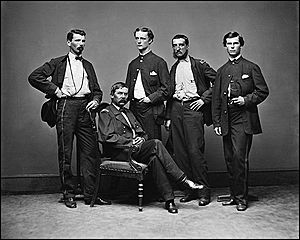
General George B. McClellan, commander of the Potomac Army, was impressed. He described Keogh as "a most gentlemanlike man, of soldierly appearance." Keogh served on McClellan's personal staff for a few months, including during the Battle of Antietam. After McClellan was removed from command, Keogh joined General John Buford's staff in November 1862.
Key Battles and Promotions
Keogh served with Buford during the Stoneman Raid in April 1863 and the cavalry battle at Brandy Station on June 9. Buford's cavalry fought well in June 1863, skirmishing with Confederate forces led by J.E.B. Stuart in Loudoun County, Virginia, especially at Upperville.
On June 30, Buford and Keogh rode into Gettysburg. Buford quickly realized they faced a larger Confederate force. He set up defenses to hold the important high ground around Gettysburg. This started one of the most famous battles in American history. Buford's smart defense and his men's bravery allowed Union troops to arrive and hold key positions. The Union army won a very important victory.
Myles Keogh was recognized for his "gallant and meritorious services" during the battle. He was promoted to the rank of major.
After Gettysburg
The Battle of Gettysburg was a turning point in the war. However, it also affected General Buford's health. Five more months of constant fighting worsened his condition. Keogh stayed by Buford's side, caring for him until Buford died from typhoid in Washington. Keogh attended his funeral and traveled with his body.
Major Keogh then became an aide to General George Stoneman. In July 1864, Stoneman led raids behind Confederate lines. Their goal was to destroy railroads and free Union prisoners.
During the Battle of Sunshine Church in Georgia on July 31, 1864, Keogh and Stoneman's command were surrounded and captured. Keogh was a prisoner of war for two and a half months. He was released thanks to General William Tecumseh Sherman's efforts. Keogh later received another promotion to lieutenant colonel for his bravery with Stoneman.
His commanders praised Keogh highly:
- General Jacob D. Cox called him "par excellence a cavalry officer."
- General John M. Schofield said he was "one of the most gallant and efficient young cavalry officers."
- General George B. McClellan found him "a most gentlemanlike man, of soldierly appearance."
- General George Stoneman described him as "one of the most superior young officers in the army."
After the war, Lieutenant Colonel Keogh chose to stay in the army. He became a second lieutenant in the 4th Cavalry in May 1866. In July 1866, he was promoted to Captain and joined the 7th Cavalry at Ft. Riley in Kansas. He took command of Company I. George Armstrong Custer was the regiment's deputy commander.
Life on the Frontier
Keogh was generally well-liked by other officers. However, life on the western frontier could be lonely. He sometimes felt sad.
He never married, but he carried a photograph of Josephine Buel, the sister of Captain Thomas Mower McDougall, with him to Little Bighorn.
Keogh was responsible for defending the Smoky Hill route from Indian raids from late 1866 to mid-1867. In 1868, he fought Indians almost daily with Sully's expedition. It was during one of these fights that his horse, Comanche, was first wounded and got its name. Keogh found it difficult to fight an enemy who did not use traditional battle methods. He wrote to his family that it was hard to find Indians without knowing where to surprise their camp.
In the summer of 1874, Keogh visited his home in Ireland for seven months. He supported his sisters after their parents died. In October, Keogh returned to Fort Abraham Lincoln to rejoin Custer. Before leaving, he bought a life insurance policy and wrote a letter to friends in Auburn, New York. He asked to be buried there if he was killed.
The Battle of Little Bighorn
Keogh died during Custer's Last Stand at the Battle of the Little Bighorn on June 25, 1876. He was the senior captain among the five companies wiped out with Custer that day. Keogh died in his own "last stand," surrounded by the men of Company I.
When the dead were buried three days later, Keogh's body was found in the middle of his troopers. His body was stripped but not harmed. This might have been because of the religious medal he wore around his neck. Keogh's left knee was shattered by a bullet, and his horse was also wounded, suggesting they fell together.
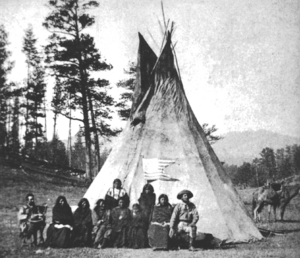
His horse, Comanche, was found badly injured on the battlefield. It was nursed back to health and became the 7th Cavalry's mascot until its death in 1890. Comanche is known as the only U.S. military survivor of the battle. Keogh's bloody glove and the flag (guidon) of his Company I were found by the army three months later.
Keogh was first buried on the battlefield. Later, his remains were moved to Fort Hill Cemetery in Auburn, New York, as he had wished. He was buried on October 26, 1877. The city held a special ceremony with a military procession.
Tongue River Cantonment in Montana was renamed Fort Keogh in his honor. Today, the 55,000-acre fort is an agricultural experiment station. Miles City, Montana, is located near the old fort.
Keogh's Burial
Myles W. Keogh was buried at Fort Hill Cemetery in Auburn, New York, on October 26, 1877. The funeral procession included pallbearers, a city band, military groups, and carriages. Flags in the city were flown at half-mast. Soldiers fired guns during the march and at the grave.
The casket was covered with the American flag and flowers. The grave was decorated with evergreens and flowers. A monument base was also covered with flowers. A minister read a service, the band played music, and soldiers fired three volleys. Friends stayed until the grave was closed.
The Throop-Martin family, who were friends with Keogh, arranged his burial and monument. The monument is a white obelisk with an inscription from a poem: "Sleep soldier still in honored rest, Your truth and valor wearing; The bravest are the tenderest, The loving are the daring." A marble cross was added later at his sister's request.
Military Ranks and Career
Here are the main ranks Myles Keogh held in the U.S. military:
- Appointed Captain, US Volunteers, April 9, 1862
- Promoted Major, US Volunteers, April 7, 1864
- Given the honorary rank of Lieutenant Colonel, US Volunteers, March 13, 1865
- Left the US Volunteers, September 1, 1866
- Appointed Second Lieutenant, Regular Army, May 4, 1866
- Promoted Captain, Regular Army, July 28, 1866
- Killed in action, June 25, 1876


